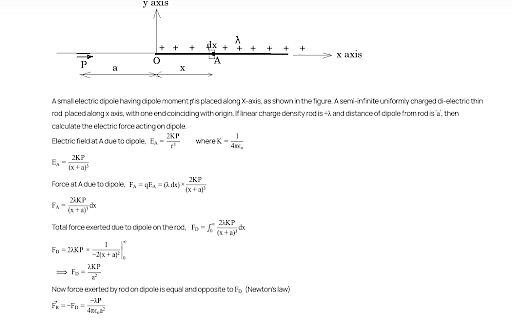A hollow sphere of radius 'r' encloses an electric dipole composed of two charges +q and -q. The net flux of electric field through the surface of the sphere due to the enclosed dipole is:
\(\frac{2q}{ε_{0}}\)
\(\frac{2q}{ε_{0}}\)4\(\pi\)r2
infinite
Zero
\(\frac{q}{ε_{0}}\)
The Correct Option is D
Approach Solution - 1
A hollow sphere encloses an electric dipole (+q and -q charges).
Gauss's Law
\[ \Phi = \frac{Q_{enc}}{\epsilon_0} \]
Where \( Q_{enc} \) is the net charge enclosed by the surface.
For a dipole: \( Q_{enc} = (+q) + (-q) = 0 \)
Determine Electric Flux \[ \Phi = \frac{0}{\epsilon_0} = 0 \]
Approach Solution -2
1. Recall Gauss's Law:
Gauss's Law states that the net electric flux through any closed surface is equal to the total charge enclosed within the surface divided by the permittivity of free space (\(\epsilon_0\)):
\[\Phi = \frac{Q_{enclosed}}{\epsilon_0}\]
2. Determine the enclosed charge:
The electric dipole consists of two charges: +q and -q. The total charge enclosed by the hollow sphere is the sum of these two charges:
\[Q_{enclosed} = +q + (-q) = 0\]
3. Calculate the net flux:
Since the enclosed charge is zero, the net electric flux through the surface of the sphere is also zero:
\[\Phi = \frac{0}{\epsilon_0} = 0\]
Top Questions on Electrostatic potential
- What is the energy stored in a capacitor of capacitance \( C = 10 \, \mu\text{F} \) when a potential difference of \( V = 20 \, \text{V} \) is applied across it?
- MHT CET - 2025
- Physics
- Electrostatic potential
You are given a dipole of charge \( +q \) and \( -q \) separated by a distance \( 2l \). A sphere 'A' of radius \( R \) passes through the centre of the dipole as shown below and another sphere 'B' of radius \( 2R \) passes through the charge \( +q \). Then the electric flux through the sphere A is
- KCET - 2025
- Physics
- Electrostatic potential
- The electric field at a point in space is \( 2 \times 10^3 \, \text{N/C} \) and the potential at the same point is 100 V. What is the potential energy of a charge of 5 μC placed at that point?
- MHT CET - 2025
- Physics
- Electrostatic potential
- Three-point charges \( Q \), \( q \), and \( -q \) are kept at the vertices of an equilateral triangle of side \( L \). What is the total electrostatic potential energy of the system?
- MHT CET - 2025
- Physics
- Electrostatic potential
Two charges, \( q_1 = +3 \, \mu C \) and \( q_2 = -4 \, \mu C \), are placed 20 cm apart. Calculate the force between the charges.
- MHT CET - 2025
- Physics
- Electrostatic potential
Questions Asked in KEAM exam
- Benzene when treated with Br\(_2\) in the presence of FeBr\(_3\), gives 1,4-dibromobenzene and 1,2-dibromobenzene. Which type of reaction is this?
- KEAM - 2025
- Haloalkanes and Haloarenes
- Given that \( \vec{a} \parallel \vec{b} \), \( \vec{a} \cdot \vec{b} = \frac{49}{2} \), and \( |\vec{a}| = 7 \), find \( |\vec{b}| \).
- KEAM - 2025
- Vector Algebra
- Evaluate the integral: \[ \int \frac{\sin(2x)}{\sin(x)} \, dx \]
- KEAM - 2025
- integral
- If \( A \) is a \( 3 \times 3 \) matrix and \( |B| = 3|A| \) and \( |A| = 5 \), then find \( \left| \frac{\text{adj} B}{|A|} \right| \).
- KEAM - 2025
- Matrix Operations
- If $ \cos^{-1}(x) - \sin^{-1}(x) = \frac{\pi}{6} $, then find } $ x $.
- KEAM - 2025
- Trigonometric Equations
Concepts Used:
Electric Dipole
An electric dipole is a pair of equal and opposite point charges -q and q, separated by a distance of 2a. The direction from q to -q is said to be the direction in space.
p=q×2a
where,
p denotes the electric dipole moment, pointing from the negative charge to the positive charge.
Force Applied on Electric Dipole
